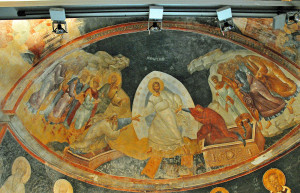The “Church of Christ the Savior in Chora” derives its name from a fourth century monastery in the same location, which was outside the walls of Constantinople and therefore in “chora,” Greek for “the countryside.” Byzantine Emperor Justinian built a church on the site in the sixth century, apparently because it was near his summer palace. After additions and improvements, the building became associated with the Greek Orthodox Church after its split from the Roman Catholic Church in the Great Schism of 1054. The church attained most of its current configuration in about 1081.
In 1204, Catholic participants in the Fourth Crusade sacked Constantinople and significantly damaged the church. After Orthodox forces recaptured Constantinople in 1261, Theodore Metochites, a wealthy statesman and patron of the arts, restored the church and covered its interior with dozens of colorful mosaics and frescoes depicting the life and death of Jesus, Biblical stories and characters and scenes important to the church. The renderings are more intricate than typical art of the period. One colorful mosaic shows Metochites handing the church to Jesus. A complex gold-leaf mosaic depicts the bodily assumption of Mary into heaven. The most famous of the frescoes, labeled “anastasis” (resurrection), is on a dome near the burial chapel. Frequently emulated, it shows the returned Jesus giving a hand to Adam and Eve as they arise bodily from their graves, with other Biblical figures watching nearby.
In 1453, the Ottoman Turks conquered Constantinople, renamed it Istanbul and turned the Chora Church into a mosque, complete with a minaret. Because Islam forbids “graven images,” they covered the mosaics and frescoes with plaster, inadvertently preserving them. Beginning in 1948, the Turkish government uncovered and restored the images and reopened the church in 1958 as a museum. Many visitors to Istanbul overlook the splendors of the Chora Church. Don’t be among them.
